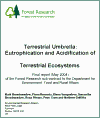As one of a number of contractors to the DEFRA Terrestrial Umbrella: Eutrophication and Acidification of Terrestrial Ecosystems, our Soil and Water Sustainability Group has an active role in:
- Developing and testing the methodology for calculating threshold rates (Critical loads) of acid deposition to UK forest soils
- Monitoring forest soils to assess recovery as acid deposition continues to fall in line with emissions reductions (current trends in Level II sites).
The principal roles of Forest Research are to provide expert advice and to deliver a range of site specific environmental, soil and vegetation-related parameters and data-sets required for the evaluation of the Critical Loads methodology. This evaluation includes the testing and calibration of process-based dynamic models of soil chemistry.
The data-sets supplied are based upon measurements made in the UK plots within the EC and UNECE-ICP (Forests) Intensive Forest Health Monitoring Network (Level II) which were established in 1994-5. Most data-sets are available from 1996 and include:
- Deposition measured as bulk precipitation and throughfall
- Soil solution chemistry
- Foliar chemistry
- Ground vegetation composition and community structure
- Litter biomass and chemistry
- Soil chemistry and profile description
- Crown condition.
Additional measurements have been made where required, including litter chemistry and soil solution DOC.
Critical load exceedance maps for nutrient nitrogen and acidity have been amended to account for forest management activities (thinning, harvesting and fertilisation) that can affect nitrogen and base cation removal or addition. This process has involved updating the uptake term in the Simple Mass Balance Equation based on growth estimates and new nutrient concentration measurements have been made across the Level II network. Managed and unmanaged woodland has been mapped separately by combining three woodland cover maps from different sources. The managed woodland category has been further categorised into conifer and broadleaf woodland to enable critical load exceedances to defined receptors for each woodland type to be mapped.
Final report (PDF-636K)
Effects of excess nitrogen
A significant proportion of UK forests’ nutrient needs come from atmospheric sources. Nitrogen is the main nutrient supplied and, on some sites, ‘saturation’ is possible. Detrimental effects of excess nitrogen include water pollution, nutrient imbalance, shoot/root imbalance and susceptibility to frost and other stresses. The effects of excess nitrogen on the forest ecosystem have been studied:
- By identifying excess nitrogen deposition through budgeting studies
- Using the ‘critical loads’ approach, where damage to the ecosystem is considered to have occurred if inputs exceed a critical threshold
- By studying soil mineralisation, denitrification and volatilisation rates.
To date, the evidence for damage is equivocal, with some studies showing saturation while others suggest that excess nitrogen causes no damage to the soil.
The participation of Forest Research within the Terrestrial Umbrella provides a basis for an extension of this detailed, long-term environmental data-set, to include additional sites, species and measurements. An on-going process of comparing observed temporal and spatial trends in the principal indicators of ecosystem damage and recovery with outputs from dynamic models will enable the effectiveness of emissions control policies to be monitored and the success of alternative policies to be predicted.
Future research
- Investigation of the spatial variation of nitrogen deposition and its effect on nitrogen saturation in forest ecosystems
- Comparison of sites with a distinct gradient in N deposition to determine its effects on soil chemistry and tree performance
- Investigation of the effects of predicted climate change on the uptake term of the critical load equation; the potential for incorporating regional variability in the effects of climate change will be assessed.
- There is uncertainty in the equilibrium pH of pristine peats; this will be investigated through a survey of available literature and data, providing a more robust basis for the setting of the critical pH for peat soils.
